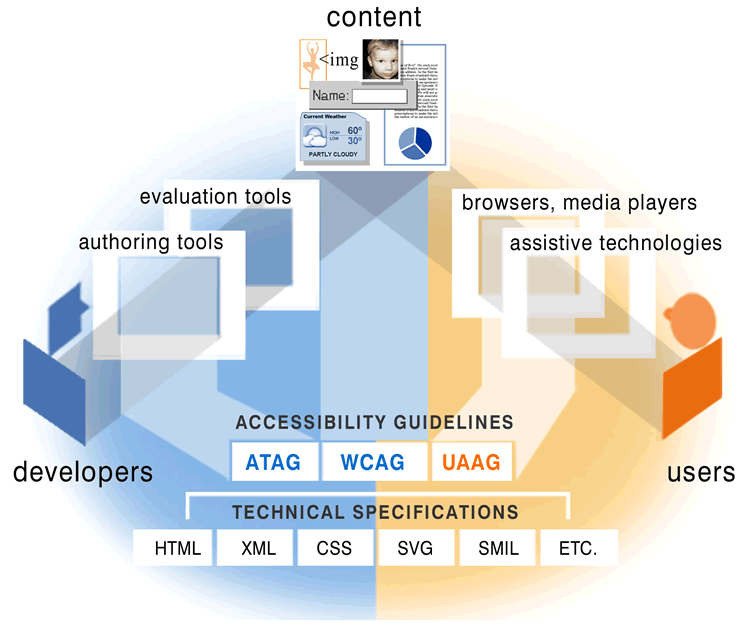W3C Web Accessibility Initiative (WAI)
Develops strategies, guidelines, resources to make the Web accessible:
- Accessibility support in W3C technologies
- Guidelines for implementing accessibility
- Methods for evaluating accessibility
- Conducting education and outreach
- Coordinating with Research and Development
What is Web Accessibility?
Web accessibility means that people with disabilities can use the Web equally
-- John Slatin.
It is part of creating an inclusive, universal Web:
- Multilingualism
- Social inclusion
- Digital literacy
- Connectivity
- ...
People with Disabilities
Are a heterogenous group, like any other group. This includes:
- Varying preferences and needs
- Different levels of expertise
- Many tools and configurations
- ...
How to Address?
Context is key. User-centered design helps you understand the context.
Some supporting resources include:
Technically Speaking...
Web accessibility is supported by several key components:
- Base Format - technologies such as (X)HTML, CSS, SVG, SMIL, PDF, Flash, Silverlight, ...
- Authoring Tools - code editors, CMS, blog, wiki, save-as tools, conversion tools, ...
- User Agents - Web browsers, media players, browser plug-ins, assisitive technology, ...
- Web Content - text, images, audio, video, code, markup, structure, presentation, ...
Components of Web Accessibility

WAI Guidelines
WAI develops and maintains a set of web accessibility guidelines:
Introducing WCAG 2.0
Web Content Accessibility Guidelines (WCAG) 2.0
- W3C web standard since 11 December 2008
- Technology-independent
- Objectively testable
- Flexible for situations
- Support for developers
WCAG 2.0 - Structure
WCAG 2.0 provides technology-independent functional requirements:
- Principles (4)
- Guidelines (12)
- Success Criteria - Level A (25)
- Success Criteria - Level AA (13)
- Success Criteria - Level AAA (23)
- Conformance
WCAG 2.0 Techniques
Techniques are technology-specific (e.g. HTML, CSS, AJAX, ...):
- Sufficient Techniques - minimum requirements
- Advisory Techniques - additional improvements
- Common Failures - often encountered mistakes
WCAG 2.0 Quick Reference
A dynamic interface to help developers manage WCAG 2.0 resources:
How To Meet WCAG 2.0
Specific contexts?
WCAG 2.0 allows implementation in specific contexts, such as:
- Web applications
- Mobile devices
- Digital television
- ...
Web Applications
Accessible Rich Internet Applications (WAI-ARIA) 1.0:
- Adds semantics to base web technologies such as HTML
- Is a technique to help meet WCAG 2.0 Success Criteria
- Does not replace WCAG, ATAG, or UAAG; it supports WCAG
Three Take-Aways
- Developers need to understand the basics first
- Use How To Meet WCAG 2.0 quick reference guide
- Authoring tools are critical for accessibility